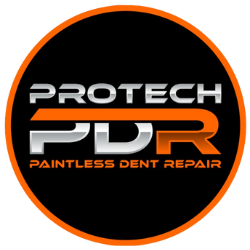
Frequently Asked Questions
General Questions
-
PDR is a method of repairing dents and dings on a vehicle's surface without the need for repainting or using fillers. It restores the car’s original finish.
-
Skilled technicians use specialised tools to gently push or pull the dented area back into its original shape, preserving the factory paint.
-
PDR is effective for minor dents, dings, and hail damage, provided the paint is not cracked or damaged. If it is cracked however a technician may repair the dent and prepare it for paint.
-
It depends on the dent's size, depth, and location. PDR is suitable for many large dents if the paint is intact and the metal isn't overly stretched.
Process & Time
-
Minor dents can be fixed in as little as 30 minutes to a few hours. Larger or more complex dents may take a day or two.
-
It depends on the damage and the technician's schedule. Many repairs can be completed while you wait.
-
Yes, many PDR technicians offer mobile services and can repair your vehicle at your home or workplace. Protech PDR certainly can!
-
Appointments are recommended to ensure the technician can assess your vehicle and provide timely service. Mobile repairs are appointment only it is best to call and discuss availability.
Hail Damage
-
Yes, PDR is one of the most effective methods for repairing multiple hail dents without repainting. In some extreme cases a combination repair may require paint or panel work.
-
Repairing hail damage can take anywhere from one to five days, depending on the extent of the damage. You can expect further delays if paint and parts are required in order to complete the repair process.
-
If the cost of repairs exceeds your excess/deductible, it’s usually worth filing a claim.
-
No, severe hail damage that cracks the paint or deforms panels may require traditional repair methods.
After the repair
-
No, once repaired, the dents will not return unless the vehicle is damaged again.
-
No, PDR preserves the original paint as long as it wasn’t already damaged before the repair.
-
No special maintenance is required, but regular cleaning and waxing will help keep the finish in excellent condition.
-
Many technicians offer warranties on their work, ensuring the quality of the repair. Protech PDR offers lifetime warranty on all PDR repairs.
Benefits of PDR
-
PDR is faster, more affordable, and maintains the car’s original paint, preserving its resale value.
-
Yes, PDR is typically more cost-effective because it requires less time and no expensive materials like paint or filler.
-
No, PDR retains your vehicle’s factory finish, which helps maintain its value.
-
Yes, since PDR doesn’t use paint, filler, or harsh chemicals, it’s an eco-friendly option.
Compatibility with Vehicles
-
PDR is suitable for most passenger vehicles & motorcycles, as long as the damage meets the repair criteria and the paint is intact. Most trucks (semis), buses and machinery will not meet PDR criteria.
-
Yes, but aluminum is more challenging to work with, so the process might take longer or cost more.
-
Yes, PDR is an excellent choice for classic cars as it preserves the original paint and finish.
-
It depends on the quality of the aftermarket paint. Low-quality paint may crack or pull during the process.
Insurance & Cost
-
Many insurance policies cover PDR for hail damage or minor dents. Check with your provider for specific details.
-
The cost varies based on the size, depth, and location of the dent. Prices typically range from $100 to $500 for most minor dents. Larger dents can exceed $1000 in some cases.
-
Small claims might not affect your premium, but it’s best to confirm with your insurer.
Other Questions
-
DIY kits are available, however professional technicians have the expertise and tools to achieve better results without risking additional damage. It can take years of experience & training to perfect the craft of PDR. So it is highly recommended to…leave it to the professionals.
-
Look for reputable technicians with positive reviews and experience in your area.

